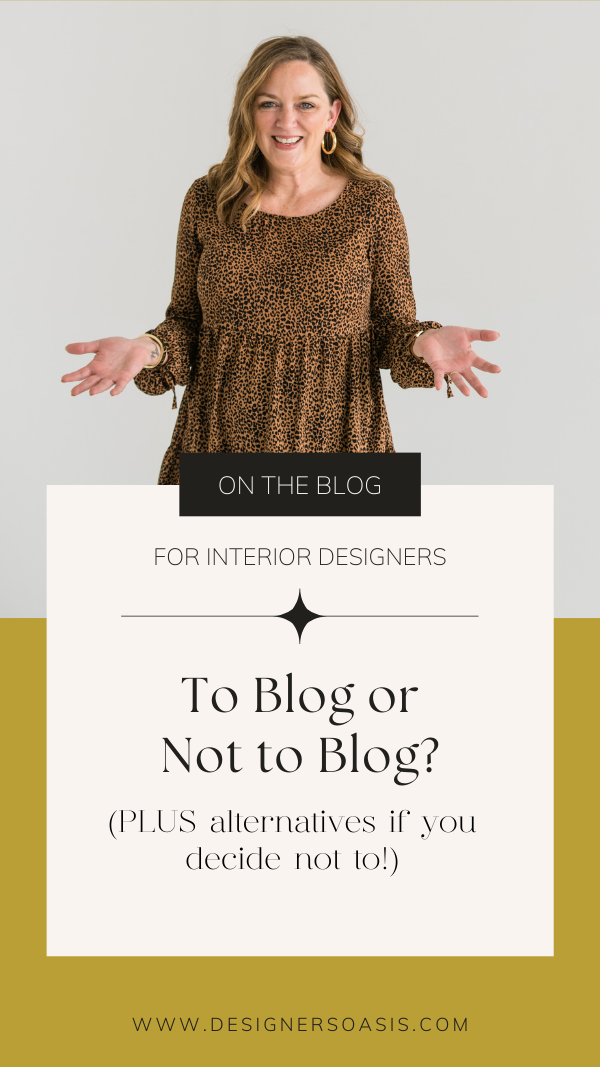To Blog or Not to Blog? Plus alternatives if you decide not to
Having a blog for your interior design website is an incredibly powerful tool for being discovered and positioning you (and your brand) in your market. However, blogging isn’t for everyone. In this post, I’ll share the 3 primary benefits of blogging as well as alternatives should you decide blogging isn’t your thing.
Here are three primary benefits to having a blog for your design business:
Improves SEO - A blog increases your chances of being found. The search engine bots like fresh activity. So if your website doesn’t have new content on a consistent basis, it may lower in the search ranks.
Establishes you as an Expert - Creating a space online for you to demonstrate your expertise and creativity as a designer is a super effective way to build trust with your potential clients, especially if you’re just starting out and don’t have a big portfolio.
Shows Your Personality - Fact: People buy from people they know, like, and trust. You don’t have to actually meet your ideal client in person for them to feel a connection with you. Giving people a glimpse into your life and personality helps build and establish a relationship with your future clients.
As you can see, these are very compelling reasons to create a blog on your website. The payoffs are huge if you remain consistent. However, maintaining a blog as an interior designer takes tremendous time and dedication. Many designers simply don’t have the time it takes or find the writing process enjoyable.
If that’s you, keep reading.
Here are alternatives to EACH benefit listed above. If you decide not to blog (which is totally cool too), consider picking one method listed below to achieve these benefits:
#1 Improve Your SEO
Newsletter: Create and send a Monthly (or Quarterly) Newsletter. Send it to your email list, but also include a searchable newsletter on your website. Here are some ideas:
Showcase a newly finished project
Share about a new product you are excited about (related to interior design)
Introduce a team member
Show progress on an existing project
Show one aspect of your process - Behind the scenes feature
Resource Section: Create a resource section on your website with evergreen information. Evergreen information is important so it remains relevant. Think about the questions clients ask over and over again. Here are some topic ideas:
Budgeting
Finding the right contractor
Tips for living through a renovation
Behind the scenes look at your Design Process
Photos and Videos: Create video and photo content for your website. Be sure to include metadata otherwise it won’t be relevant or improve your SEO.
Project Portfolio
Introduce your team (Even if it’s your pup!)
Show examples of your process (moodboards, presentation boards, showroom visits, site visits, trade days)
#2 Establish Yourself as an Expert
Think of ways to share your expertise both in-person and online. Bonus! All of these methods will naturally help with #3.
Write a column for your regional shelter magazine
Appear as a guest on your local television station - Pitch ideas based on seasonal/relevant topics
Be a guest on a podcast
Go “Live” on social media (Instagram or Facebook) - Be consistent
Speak at events (in person or virtual)
#3 Show your Personality
In addition to everything listed in #2, here are some ways people can begin to get to know you and start to build a connection.
Show your personal life - Are you vegan? Are you obsessed with animals? Love to travel?
What do you do for fun? Weekend mixologist? Paint? Run?
What city do you live in? (this is especially useful when aiming for local clients)
Who are your people? To the extent that you are comfortable, share photos of your family.
Say cheese! Post photos of yourself with a warm smile.
Got furry friends? People love to see your pets. Dogs, cats, fish, goats, bunnies, ducks, chickens, hedgehog? Let’s see ‘em
Remember, this list is intended to give you ideas. Don’t feel like you need to go do it all. Pick one or two from each of the categories and focus on that. If it works and you enjoy it...great! Otherwise, keep refining. Above all, keep it simple and aim to provide valuable information your clients will thank you for.




